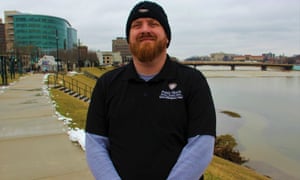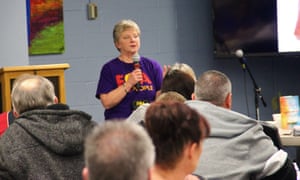04 Mar ‘Help not handcuffs’: how US cities on the frontline are fighting to stem the opioid tide | Cities
Growing up in the farmlands around Dayton, south-west Ohio, a teenage Randy Carmack knew many “little old ladies” whose cupboards contained powerful painkillers. “One had a leg amputation and she didn’t like her fentanyl patches, so I bought her prescription from her granddaughter,” he said.
Carmack had dabbled with the prescription painkiller OxyContin and morphine. But trying fentanyl, the potent synthetic opioid that killed Prince and has been most recently blamed for high fatalities in America’s opioids crisis, got him really hooked.
By his mid-20s, Carmack, now 37, used cocaine, heroin or fentanyl daily. After being caught taking money from the vending machines he serviced for his father’s company in 2011, Carmack was kicked out of the family home. He stayed in abandoned buildings and on his dealer’s sofa in Dayton. He lost friends who fatally overdosed.
“There were so many horrible things I’d done during my drug use that I thought it defined me,” he said. Alone one evening at his dealer’s house and finding his lowest ebb, he contemplated suicide.
The next day he walked into a crisis care center and entered residential recovery. Now he’s a certified peer recovery supporter at the public health department.

This turnaround reflects the success Dayton has had in tackling the opioids crisis. Through various “help not handcuffs” measures the city halved opioid deaths last year and more places are now trying a similar approach.
With a population around half a million, opioids have scarred Dayton. In 2017, 577 accidental overdose deaths were recorded, a fourfold increase since 2010 and one of the highest per capita rates nationally. Police departments, emergency rooms and morgues were overwhelmed.
The crisis spurred county health officials, city authorities, community groups and law enforcement agencies to cooperate like never before. In 2016 the Community Overdose Action Team (Coat) was created.
“The numbers (of deaths) were continuing to rise,” said Barbara Marsh, a co-lead of Coat and a health official for Dayton and Montgomery county. “We needed to align efforts; we needed to leave egos at the door and work together.”
Health officials started needle exchange programs and also used them to contact 4,000-plus drug users, normally a tricky population to track outside the criminal justice system. Police and emergency responders were equipped with the nasal spray kit Narcan that quickly revives overdosers.
Instead of routinely arresting those addicted, a police team now calls or visits users shortly after they overdose, offering help. Doctors running illegal “pill mills” were hit with lengthy prison sentences. And public money was procured for treatment, out-patient and recovery facilities.
The Coat program is credited with remarkable developments. In the first half of 2018, drug overdose deaths in Dayton’s Montgomery county fell 65%. Overdose emergency department visits dropped 73%, while police and emergency calls to deal with overdoses dropped two-thirds.
Government 2017 figures show opioid-related overdoses killed someone every 11 minutes in America, 47,600 fatalities.

The federal government is widely considered out to lunch on the crisis. “Until a few years ago [the crisis] was neglected and misunderstood,” said Andrew Kolodny, co-director of Opioid Policy Research at Brandeis University. . “The Obama administration’s treatment of the opioid crisis was worse than [Ronald] Reagan’s dealing with the Aids crisis.”
Cities and counties are leading efforts to stem the opioid tide and the public health catastrophe.
Some, like Dayton, believe they see light at the end of the long tunnel, through the collaborative, non-custodial approach and determined outreach.
Cooperation between public agencies and swiftly visiting people at home who have overdosed, offering support services, have brought results in places like hard-hit Manchester, New Hampshire, which pioneered that approach, and parts of Ohio, North Carolina, Indiana, Kentucky and beyond.
There are other hopeful innovations.
• Cincinnati created the Heroin Tracker app to pinpoint overdoses by location, date and time, updated through the 911 system, to speed assistance.
• Denver piloted a controversial project where addicts safely use drugs in designated spaces, cutting deaths and giving easier avenues to rehab services.
• In Cary, near Raleigh, North Carolina, overdose increases around 70% baffled authorities. Cary deployed portable robots at strategic points in the sewers to test human waste for opioid metabolites – a US first. Known as “hot-spotting,” each robot reports waste from up to 15,000 residents and highlights which communities use specific opioids and how much. While it does not identify individuals and results are not yet public, it forewarns of problems.
• Palm Beach county, Florida, unleashed lawyers to crack down on fraudulent private rehab centers and halfway houses, while boosting availability of social workers to direct addicts to reliable services.
But that compassionate approach is not embraced everywhere. Big Horn, Montana, authorities last year encouraged residents to report pregnant women suspected of being under the influence of drugs or alcohol to police, for example. Some US police departments, including Butler county, an overdose-plagued district south of Dayton and, until January, Washington DC don’t allow law enforcement to carry Narcan, citing dangers to officers.

And although enormous strides have been made in Dayton, visits to recovery centers and support groups suggest things are far from solved. About 90 people recently packed a meeting of Families of Addicts, which helps relatives embroiled in the crisis. One man said he had been off drugs for 17 months. But a young woman with her parents and toddler broke down while recounting her relapse three days previously.
A mother said her faith has helped after losing her daughter to an overdose.
“Fentanyl is still the biggest opioid problem in Dayton,” said FOA founder Lori Erion. Erion said Dayton suffered when narcotics were overprescribed in the 2000s and then many who became addicted reached for the black market in desperation when the scripts dried up. In 2017, Dayton’s mayor, Nan Whaley, announced a lawsuit againstpharmaceutical companies, pain specialists and distributors, shortly after a state suit and now one of many others.
As the Families of Addicts meeting filled up, Erion constantly checked her phone. Her daughter April, 24, is fighting heroin addiction and was due at rehab the next morning, but had abruptly left home. Erion feared she had gone for one last hit.
“I’m exhausted. I’m not helping her any more,” she said, exasperated.
A police crackdown on narcotics supplyhas spurred checks of bus stations and package delivery services. And hotels are asked to submit guest lists, to match names with suspected drug dealers.
Barbara Marsh said the biggest challenge remains the shame attached to drug use. “As long as we have a stigma around the disease, individuals are less likely to reach for help,” she said. “Addiction is still seen as a moral failure, but we should treat it as we would any other disease.”
Hope prevails. Carmack once spent his days sitting in his car getting high but now he is driving around wintry Dayton looking for overdose victims, saying county recovery efforts have been enormous.
“Outreach has transformed this community,” he said.
• The Substance Abuse and Mental Health Services Administration’s (SAMHSA) national Helpline –1-800-662-HELP (4357) is a free, 24-hour, confidential treatment referral and information service (in English and Spanish) for individuals and families facing mental and/or substance use disorders.
• Follow Guardian Cities on Twitter, Facebook and Instagram to join the discussion, catch up on our best stories or sign up for our weekly newsletter
[ad_2]
Source link



No Comments